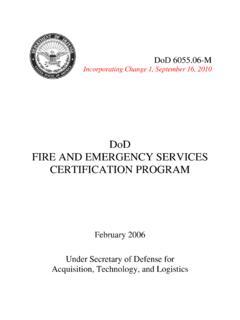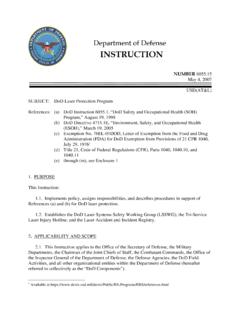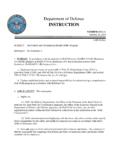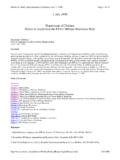Transcription of BY ORDER OF THE AIR FORCE POLICY DIRECTIVE 91 …
1 BY ORDER OF THE AIR FORCE POLICY DIRECTIVE 91-2. SECRETARY OF THE AIR FORCE . 1 MAY 2017. Safety SAFETY PROGRAMS. COMPLIANCE WITH THIS PUBLICATION IS MANDATORY. ACCESSIBILITY: Publications and forms are available on the e-Publishing web site at for downloading or ordering. RELEASABILITY: There are no releaseability restrictions on this publication OPR: AFSEC/SEI Certified by: AF/SE. (Maj Gen Andrew Mueller). Supersedes: AFPD 91-2, 24 July 2012 Pages: 8. This Air FORCE POLICY DIRECTIVE (AFPD) is consistent with DoD DIRECTIVE (DoDD) , DoD Explosives Safety Management and the DoD Explosives Safety Board; DoD Instructions (DoDI) , DoD Safety and Occupational Health (SOH) Program, , DoD Traffic Safety Program, and , Mishap Notification, Investigation, Reporting and Record Keeping.
2 This AFPD interfaces with and is consistent with AFPD 63-1_20-1, Integrated Life Cycle Management, and DoDIs , Occupational and Environmental Health (OEH), , DoD Hazard Communication (HAZCOM) Program, , DoD Laser Protection Program, , Protecting Personnel from Electromagnetic Fields, and AFPD 51-5, Military Legal Affairs. This AFPD may not be supplemented at any level per AFPD 90-1, POLICY Formulation, and AFI 33-360, Publications and Forms Management. It applies to active duty members, Department of the Air FORCE (DAF) civilians, Air National Guard (ANG) members and Air FORCE Reserve (AFR) personnel. Refer recommended changes and questions about this publication to the Office of Primary Responsibility (OPR) using the AF Form 847, Recommendation for Change of Publication; route AF Forms 847 from the field through appropriate functional's chain of command.
3 Ensure that all records created as a result of processes prescribed in this publication are maintained in accordance with Air FORCE Manual (AFMAN) 33-363, Management of Records, and disposed of in accordance with Air FORCE Records Disposition Schedule (RDS) in the Air FORCE Records Information Management System (AFRIMS). 2 AFPD91-2 1 MAY 2017. SUMMARY OF CHANGES. This publication has been substantially revised and must be completely reviewed. This publication rescinds and integrates AFPD 91-3. The Air FORCE will have a comprehensive safety program to identify and control hazards and to prevent mishaps.
4 This DIRECTIVE establishes POLICY for the Air FORCE 's Safety Program. It consolidates Safety Program Management and Occupational Safety and Health publications to provide an integrated framework for safety management. 1. Overview. Air FORCE leadership is committed to providing safe, healthful environments both for Air FORCE personnel and for those affected by Air FORCE operations. This DIRECTIVE describes the necessary overarching structure, including policies, roles and responsibilities that enable the Air FORCE to manage its Safety Programs efficiently and effectively. Safety programs preserve resources to maximize combat capability by eliminating mishaps through proactive hazard identification and risk management.
5 Foundational elements of this concept are: Identify and Mitigate Hazards. Airmen must be capable of: identifying threats/hazards to successful task accomplishment on- and off-duty; taking action to identify and implement measures to reduce the risk associated with those hazards; and elevating risk acceptance decisions to the appropriate level within the chain of Command. Investigate Reportable Mishaps. Understanding organizational, supervisory, and individual circumstances and pre-conditions surrounding mishaps is fundamental to preventing the recurrence of similar mishaps in the future and must be incorporated back into system design and acquisition processes.
6 Safety Investigations focus solely on mishap prevention and will not be used for punitive purposes. Safety Reports, their attachments, and privileged information extracted from them will not be used as evidence for punitive, disciplinary, or adverse administrative actions. Privileged information will not be used as evidence in determining the misconduct or line-of-duty status of any personnel, or as evidence in a flying evaluation board. The Safety Investigation Board (SIB) is separate and distinct from the Aerospace or Ground Accident Investigation Board (AIB) convened under the auspices of AFI 51-503 to provide the publicly releasable record of the event.
7 Prevent Mishaps. The Air FORCE goal is to reduce the number of mishaps, occupational injuries and illnesses to zero. To this end, commanders will establish and support Safety programs that reduce or eliminate risk to personnel, equipment, facilities, and operations. Safety Training. A workforce trained to recognize and assess hazardous situations and conditions is the first step toward mishap elimination. All personnel and their supervisors must be trained in the proper application of safety principles to reduce: personnel injury or fatalities; equipment damage or loss; and mission degradation or failure.
8 2. POLICY . The Air FORCE shall: Support Hazard Identification and Mitigation. Commanders must identify and control hazards to prevent mishaps. When mishaps do occur, Air FORCE leaders must investigate to identify the causes and mitigate hazards to ensure those mishaps are not repeated. Commanders will identify and eliminate, where feasible, or reduce all hazards to personnel, property and the general public when those hazards result from its operations. AFPD91-2 1 MAY 2017 3. Leaders and commanders must develop and support programs for hazard identification and mitigation. Air FORCE personnel must have the means to identify any real or potential condition that can: cause injury, illness or death to personnel; damage to or loss of equipment or property; mission degradation; or damage to the environment, with the expectation that commanders will employ the risk management process to eliminate or reduce the hazard.
9 When hazards cannot be eliminated, leaders, commanders and subordinates must know the specific risks involved, and manage those risks to an acceptable level for mission accomplishment. Assess and document risks associated with the hazard and use protective measures to lower the risks to the lowest level feasible. Provide Mishap Prevention. Support Mishap Investigation. The Air FORCE will investigate mishaps/hazards involving its personnel and property, to include occupational injuries and illness. Investigative efforts will continue until the Air FORCE determines all the causal factors involved in the mishap and makes its recommendations for preventing recurrence.
10 Safety mishap investigations have priority over all other related investigations of a mishap until competent authority determines the incident is outside the scope of this DIRECTIVE All Safety Mishap Reports are intended For Official Use Only; privileged information will not be disclosed outside the US Air FORCE safety community. Air FORCE Safety (AF/SE) is the decision authority on all requests for exceptions to this POLICY . At every level of its program, the Air FORCE will comply with Federal statutory and regulatory requirements and higher authority POLICY directives. This includes meeting all Federal mishap prevention objectives and safety provisions contained in status of FORCE agreements between member nations.

















